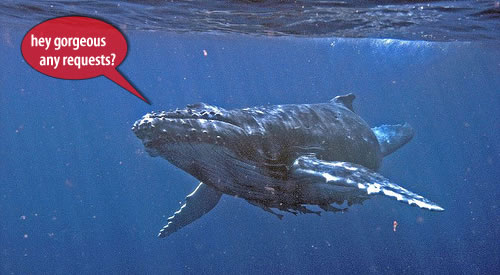
Male humpback whales are well-known for the long sweet melodies they sing during the breeding season. The soulful songs that last anywhere from ten to twenty minutes, are not random noises, but carefully orchestrated themes that keep repeating and developing. Scientists are not sure if the mammals sing to attract partners or, to deter rivals but once they get going, they tend to repeat the same tune over and over for long periods of time.
The whales do however appear to get tired of singing the same song and create a new one every year. Sometimes the “lyrics” are entirely new, while in other instances, they incorporate portions of the previous year’s melody. In 2011, University of Queensland Associate Professor, Michael Noad, and his then graduate student, Ellen Garland, discovered that the “song of the year” was not just sung by males from the same pod, but also by members of neighboring ones. In almost each case, the song originated from a humpback group on Australia's eastern coast, and then moved from pod to pod, all the way to the whales in French Polynesia — about 4,000 miles away. One song became such a super hit it was even being hummed by whales in the Atlantic Ocean. The discovery was hailed as groundbreaking, because it revealed that similar to humans, whales exchange their culture with each other, something that had never been observed in the animal kingdom before.

However, the researchers still had one unanswered question — how do the mammals learn new songs? To investigate, Garland, now a postdoctoral fellow at the University of St. Andrews, teamed up with Noad again, and listened to 9000 whale songs. Noad says, "We recorded many individual singers from several populations, including the eastern Australian population and other populations in the South Pacific. We looked for songs that were caught in the act of changing; songs that had some of the old song as well as some of the new song."
Their findings, published in the journal Proceedings Of National Academy Of Sciences on July 25, reveal that whales learn songs in segments, very similar to how humans learn languages. The researchers say they combine new song snippets with older songs that they have already memorized in one of two ways. One entails combining verses from previous and new songs, until the entire new version has been learned. The other is by inserting a single verse from a new song into the middle of an older song.

What stunned the researchers is that whales do not randomly insert new “lyrics” in the middle of an existing song. Instead, just like a master DJ, they do it at a point in the song where the tunes sound similar. Noad says, “When they [whales] switched mid-song from old song to new or from new to old, it was when the theme sounded most similar to another theme in either old or new song.” The newly-created hybrid song, therefore, always sounds flawless. If that is not enough to impress you, how about this? Humpback whales do not have vocal chords. They sing their melodies, which are audible for over a 100 miles, by blowing air through their nasal cavities!
Resources: newatlas.com,uq.edu.au